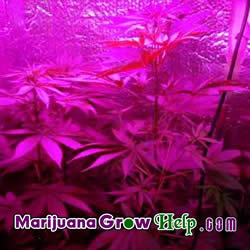Marijuana Grow Lights: Lighting Your Grow

Marijuana Grow Lights Explained
Countless debates still rage about what the ideal amount of light is for your grow area, but there are some basic standards you can follow to ensure that you’re getting a good minimum. In truth, there actually doesn’t seem to be a maximum amount of light, but there does reach a point when more light just seems to become overkill.
Before getting into the slightly more technical details of marijuana grow lights, though, let’s address canopy penetration.
Canopy penetration refers to how much of your light reaches below the canopy, or top layer of foliage, of your plants. High intensity discharge lights, like the metal halide (MH) or the high pressure sodium (HPS) are excellent for canopy penetration in a small grow room. A HPS light is also ideal for use during the flowering period, as it produces light rich in red wavelengths, encouraging budding and the formation of tight, dense nuggets.
By contrast, compact fluorescent lights (CFLs) are a more affordable but poorer choice for growing your cannabis, due to their weaker output; since they can’t penetrate the canopy as well, you’ll have to add light physically underneath the canopy if you want to get the undergrowth.
So the quality of your light is important, and most growers consider HPS and MH the go-to lights for their growing needs. The reason these HID lights are so much better at penetrating the canopy is because they put out far more lumens per square foot.
Measuring the Output of Marijuana Grow Lights

LED marijuana grow lights have gained popularity, even though there is still some argument on the benefits.
A lumen is a measurement for the amount of light produced by a light source, and for cannabis cultivation you generally need an absolute minimum of 3,000 lumens per square foot of grow space. More seasoned and professional growers take light seriously, providing between 6,000 – 10,000 lumens of light per square foot. When in doubt, just take a look at nature. On a bright and sunny day in summer (the conditions you’re mimicking for your bud) the sun can put out 10,000 lumens or more per square foot. The only real limitation on light is how much heat it produces.
From the least lumen output to the most, your common lighting options are: incandescent bulbs, a really awful choice of grow light and to be avoided; mercury vapor lights are slightly better but still pretty meh; compact fluorescents are doable, especially for first-time growers who don’t want to spend a fortune and those who are on a tight budget; and then the high intensity discharge bulbs like the metal halide and high pressure sodium.
During your first cannabis grow, here’s a good lighting schedule to follow:
- for seedling and vegetative stage 16 – 20 hours of light per day, 4 – 8 hours darkness
- to induce flowering restrict light to 12 hours during the day, 12 hours absolute dark
Technically, your cannabis can vegetate for 24 hours a day, and there are growers who speed through the vegetative stage of cannabis growth with solid light for 22 or 24 hours a day. They claim their plants grow faster, but most growers like to have a resting night period.
Whatever the case, don’t dip below 16 hours of light a day if you can help it. When you start getting down to 14 or 13 hours of light, your cannabis may begin flowering prematurely.





No comments yet.